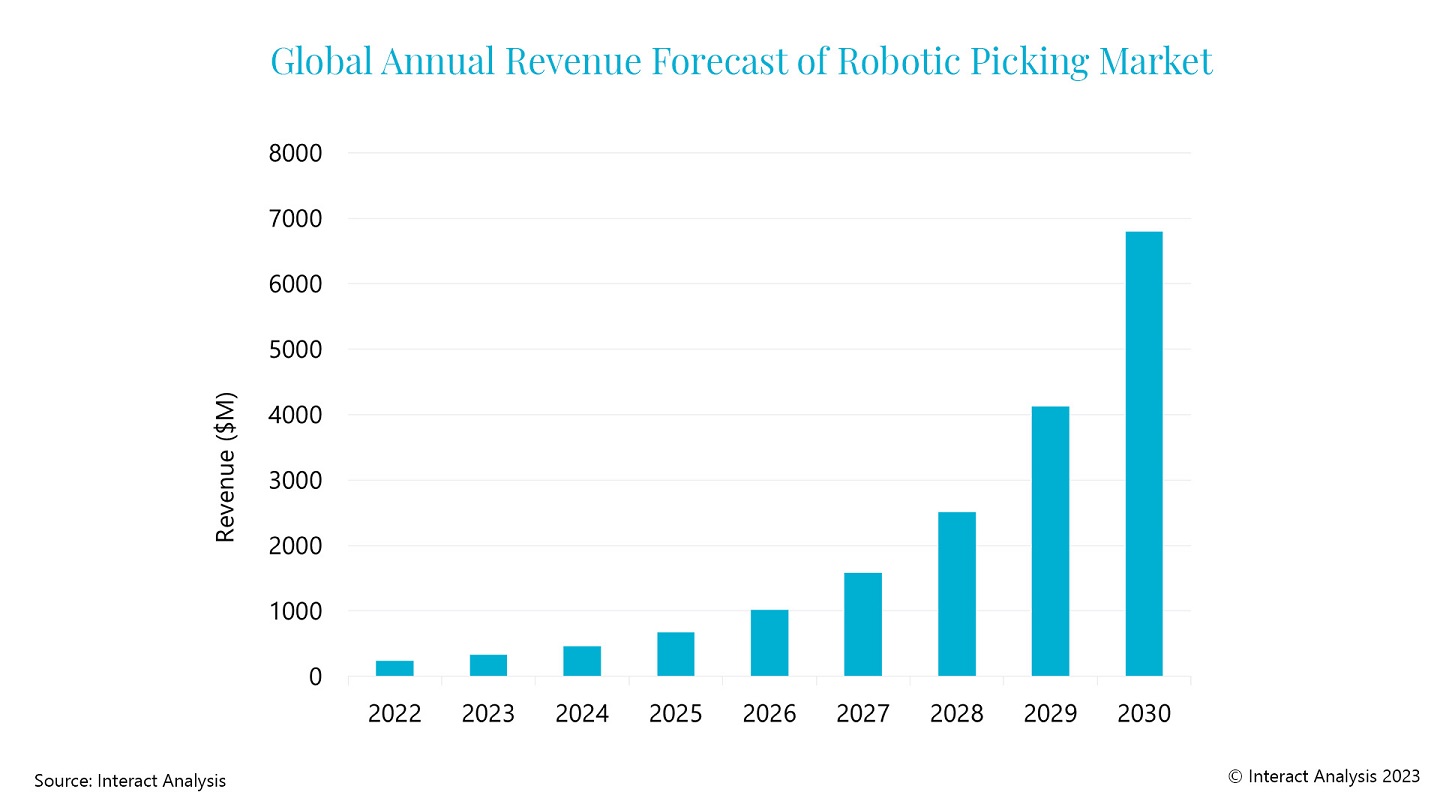Robotic picking market worth $6.8 billion by 2030, up from $236 million last year
Study by Interact Analysis finds that U.S. -based companies lead the market, while industries running 2-shift and 3-shift operations are showing faster adoption rates.

New research by Interact Analysis shows the market for robotic picking is in the early stages of growth but presents huge potential. The market was worth $236 million in 2022, but by 2030 this will increase to $6.8 billion.
Rising labor costs and supply chain constraints are likely to be key drivers for the market, as companies turn to automation to relieve operational pressures, the research firm added. The growth of e-commerce and warehouse automation is also expected to impact the market for robotic picking technology.
There are currently very few suppliers to the robotic picking market and a low installed base, Interact noted. By the end of 2022, Interact Analysis’ research shows there were just 33 suppliers in the market, most of which entered it within the last 5 years. However, despite the market currently being relatively small, there is huge growth potential for the robotic picking sector, with the increase in warehouse automation set to have a positive impact on the market. In 2022, the number of employees performing static manipulation tasks in warehouses was 4.3 million and by 2030 this figure will reach 7.5 million. This expansion will substantially increase the total addressable market for robotic picking.
There are a number of factors that are influencing the adoption speed of robotic picking technology, the research finds, one of which is shift patterns. Those companies with 2-shift and 3-shift operations have a tendency towards faster adoption rates than those with lower shift patterns as they can significantly reduce labor costs by installing the technology. The growth of e-commerce is having a huge impact on the market due to the 24/7 nature of its operations, with multiple shifts. Picking robots can work longer hours and achieve a greater number of picks than manual workers at a lower overall cost.
“The market for robotic picking is certainly an exciting and dynamic one," commented Irene Zhang, senior analyst at Interact Analysis. "The market share landscape is set to look very different in 2030 compared with today due to an influx of new vendors. The market share can alter considerably from just one supplier being awarded a large project. For example, Boston Dynamic’s $15 million deal with DHL will have a significant impact on its 2023 share of the robotic picking market."
“The U.S. considerably leads the way for the robotic picking market, and we expect this to continue over our forecast period," Zhang continued. "This is in part due to the high labor costs faced by US companies. Out of the 33 suppliers that currently serve the robotic picking market, 18 are based in the US. Not to mention, all 18 received a total of $1.4 billion in funding by the end of 2022 – accounting for 60% of global funding in this market.”

Article Topics
Interact Analysis News & Resources
Forklift market to be 50% bigger by 2032, Interact Analysis forecasts Interact Analysis: warehouse automation market to return to growth in 2024 Chinese warehouse automation market set to grow at CAGR of 13.5% over next 5 years Interact Analysis: warehouse construction declines by 25% in 2023 ‘Steady’ growth of 5-7% forecast for global industrial robot market Robotic picking market worth $6.8 billion by 2030, up from $236 million last year Interact Analysis: logistics and other new application scenarios key to cobot market success More Interact AnalysisLatest in Materials Handling
Geek+ and System Teknik deploy PopPick solution for pharmacy group Med24.dk Beckhoff USA opens new office in Austin, Texas Manhattan Associates selects TeamViewer as partner for warehouse vision picking ASME Foundation wins grant for technical workforce development The (Not So) Secret Weapons: How Key Cabinets and Asset Management Lockers Are Changing Supply Chain Operations MODEX C-Suite Interview with Harold Vanasse: The perfect blend of automation and sustainability Consultant and industry leader John M. Hill passes on at age 86 More Materials HandlingSubscribe to Materials Handling Magazine

Find out what the world's most innovative companies are doing to improve productivity in their plants and distribution centers.
Start your FREE subscription today.
April 2024 Modern Materials Handling

Latest Resources










